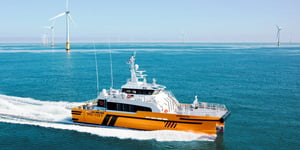The propulsion system is without doubt an important part of any vessel, including wind farm vessels. Choosing the wrong propulsion system can have severe consequences, leading to safety hazards, poor fuel efficiency and weak competitiveness.
In this blog article we discuss the operational profile of wind farm vessels as well as the characteristics of a CPP, before we look at the benefits of choosing a CPP for your wind farm vessel.
Optional profile of wind farm vessels
A typical CTV (Crew Transfer Vessels), such as a windfarm vessel, are 20-30 meters long and carry 12-24 passengers. These passengers are technicians who need to be transported safely to the windmills every morning. Furthermore, these boats often carry tools and fuel - approximately 8-10 tons in payload.
Wind farm vessels typically have three main operation modes:
High Speed condition transit to windfarm
The vessels are out on open sea, and thus should be able to manoeuvre well in high waves, strong winds or currents and varying deck load. Typically, they are out about 12 hours a day (3000-4000 operational hours per year). This is normally the most energy consuming operational condition.
Medium/Low speed transit operations in wind farm
The second operation mode is when the wind farm vessel transit between the wind turbines at speeds around 10-20 knots.
Bollard condition
In order to safely transport its passengers onto the windmill the workboats must be able to push the bow quite hard towards the windmill. Thus, it is crucial to have high bollard push/pull.
As the workboats often are out on rough sea, it is important that they are able to operate during the weather window agreed upon.
Efficient operation in the modes above requires different pitch settings for the propeller and thus requires a controllable pitch propeller.
Combining these operations in an efficient manner is thus crucial. In addition to efficiency, reliability and safety are also important factors.
Read more: The Most Valuable Energy is the One You Do Not Use
Controllable pitch propellers (CPPs)
The CPP is a propeller with changeable pitch. Meaning that the propeller pitch can be adjusted for optimum load on the engines and adjusted to different conditions such as varying vessel load, weather conditions and operation modes.
Consequently, this propulsion system can be used to run the vessel in forward and astern direction both, by turning the propeller blades in aft pitch setting without having to change the direction of rotation of the shaft. Smooth manoeuvring reducing wear and tear on the engines will also reduce engine maintenance cost.
Also, with a hybrid solution you’ll have optimal propeller pitch when in EL-mode.
Benefits of CPPs
CPPs are the preferred choice for wind farm vessels due to multiple reasons. Let’s have a look at the benefits of choosing a CPP over other propulsion systems:
- Increase thrust (bollard push) due to the adjustable pitch when the vessel pushes against the wind turbine in order to move workers and equipment safely from the boat to the turbine.
- Fuel-efficient during transport from port to field.
- Less fuel consumption, also during work.
- Increased uptime due to greater weather window due to increased BP
- Ideal for hybridization. The CPP is more suitable for hybrid propulsion solutions than water jet and fixed propeller. It can drive electrically at slow speeds and in calm weather. This allows for emission-free driving in port due to the flexibility with a CPP.
Read more: What is Important When Selecting Propulsion Technology
Conclusion
Choosing the wrong propulsion system for your wind farm vessel can lead to severe consequences. As such, the propulsion system of your vessel is considered an important investment; it can increase the ability to compete in the market with good fuel-efficiency, lesser safety-hazards and facilitation for hybridization.



